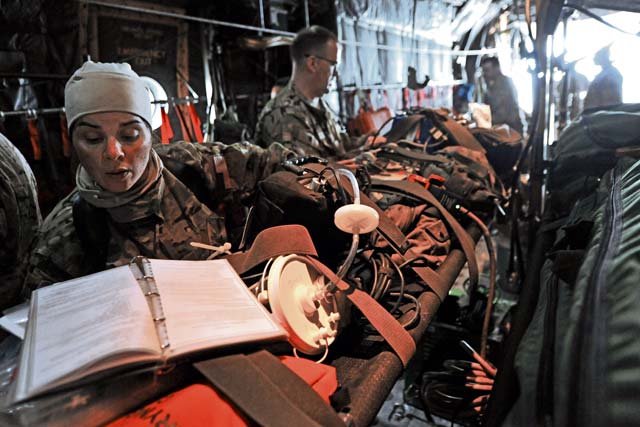
Editor’s note: This is the second in a four-part series about the 455th Air Expeditionary Wing’s medical response capabilities and the various teams within the wing that play a role in the care and transportation of combat wounded troops throughout Afghanistan. To read Part I, click here!
BAGRAM AIRFIELD, Afghanistan — More than 70 years ago, the first flight nurse graduated from the flight nurse course on Bowman Field, Ky. These flight nurses trained to provide a higher level of care to patients while they traveled by aircraft to other medical facilities.
Today, the flight nurses and technicians of the 455th Expeditionary Aeromedical Evacuation Squadron keep that level of care going in the skies above Afghanistan.
The 455th EAES provides medical and nursing care in flight to ill or injured service members or Department of Defense civilians. They perform their mission on fixed wing aircraft, including the C-17 Globemaster III, C-130 Hercules and KC-135 Stratotanker, and can provide extensive critical care capability equal to the level of care that patients receive at the Craig Joint Theater Hospital here.
“Our job is to move the sick and injured through the area of responsibility of Afghanistan,” said Col. Edward Farley, 455th EAES commander. “We obviously don’t want to be very busy, because that means that something bad has happened, and we have to move our service members or our coalition partners to a higher level of care.”
Farley, deployed from Scott Air Force Base, Ill., leads 48 medical personnel with teams of four basic crews consisting of two flight nurses and three emergency medical technicians. All flight crew members received specialized altitude training to become universally qualified to move patients by aircraft.
Tech. Sgt. Alejandro Rojas, 455th EAES medical technician, said the hardest part about his job is the uncertainty of the missions, but his team trains for the unexpected.
“Each of our teams preps and configures all of our equipment the same way,” he said. “That way no matter what aircraft or patients we get, we are ready.”
He also said that even though his unit doesn’t always stay extremely busy, primarily during the winter seasons, the necessity to have them is unquestionable.
“We are like life insurance,” Rojas said. “We are expensive, and we are not always busy, which is good, but you are really happy to have us when something goes wrong.”
Working as a cohesive unit, the members of the 455th EAES are a mix of Air Force active-duty, Guard and Reserve members from bases all over the globe. Rojas’ home station is Kadena Air Base, Japan, while other team members are from stateside bases like Joint Base McGuire-Dix-Lakehurst, N.J.
Farley said he believes his team works well together because of the awesome responsibility of their mission and just how worthwhile it can be.
“The team encounters these young and brave men and women that have gotten injured while serving their country,” he said. “We get to take them by the hand and look them in the eyes to tell them just how proud of them we are.”


